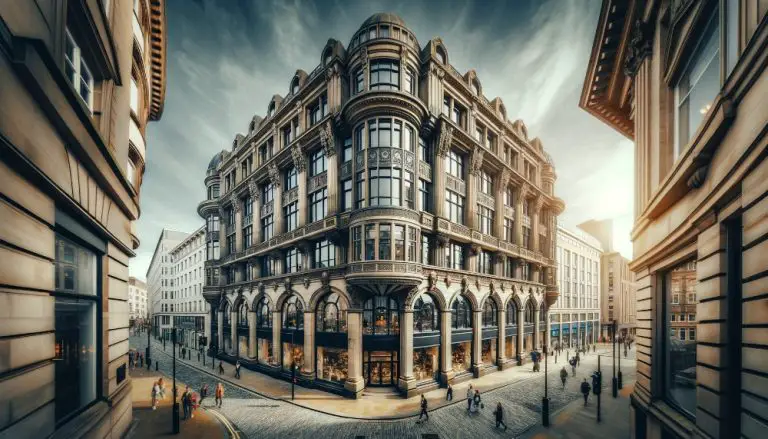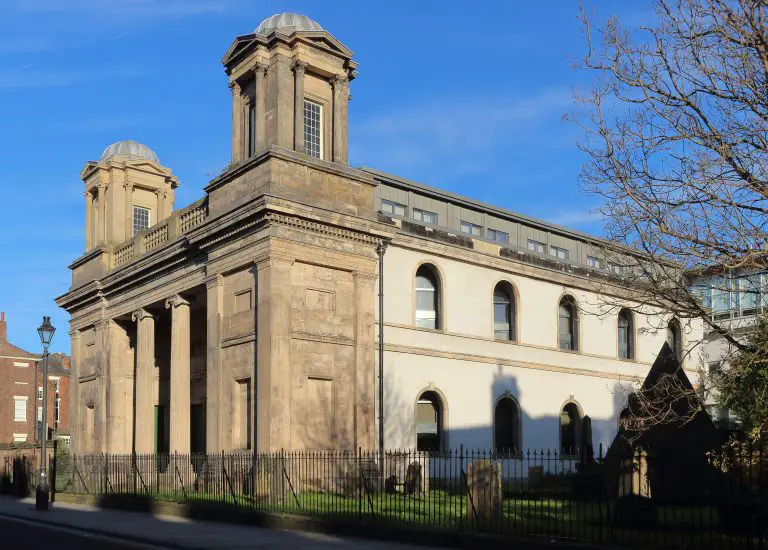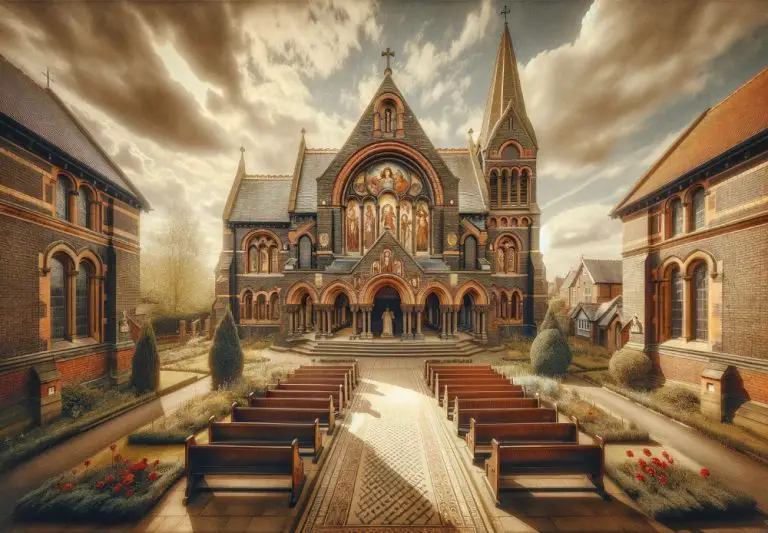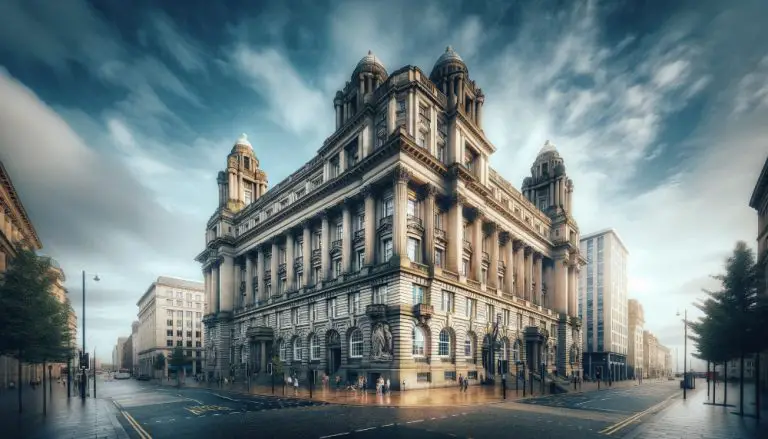Liverpool Castle: the Rise and Fall of a Lost Historical Structure
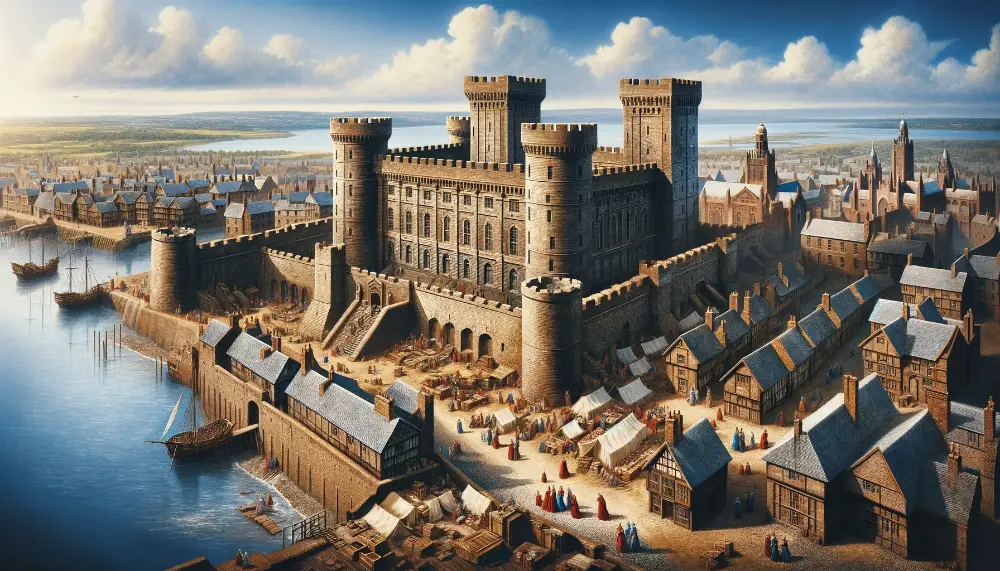
Liverpool Castle, an extraordinary historical landmark that once stood proudly above the Mersey River. This medieval fortress was a true architectural marvel, showcasing the grandeur and prestige of Liverpool’s history. Join me on a journey through time as we explore the captivating story of Liverpool Castle and its enduring legacy in Liverpool’s rich heritage.
As you delve into Liverpool’s history, you’ll discover the fascinating details of this magnificent castle. From its construction in the 13th century to its eventual demise in the 18th century, Liverpool Castle played a pivotal role in shaping the city’s past.
The castle’s occupants, the Molyneux family, had a significant influence on Liverpool’s development at the time.
Key Takeaways
- Liverpool Castle was a medieval fortress and a significant historical landmark in Liverpool’s history.
- Constructed in the 13th century, the castle boasted impressive architecture, including circular towers and an imposing gatehouse.
- Liverpool Castle fell into disrepair and was eventually demolished in the 18th century.
- Although the original castle no longer exists, a replica can be explored at Lever Park in Rivington.
The Origins of Liverpool Castle
In 1235, Liverpool Castle was constructed by William de Ferreres, a fact that corrects the misconception that it was built by King John. King John had a visionary concept of establishing Liverpool as a bustling trading town and port, aimed at generating revenue and creating a strategic base for launching attacks on Ireland. Located strategically above the Mersey River, Liverpool Castle served as a medieval fortress and offered a safe harbor for trading ships and war vessels, solidifying its significance as a stronghold against potential Irish attacks.
The purpose of the castle was, in fact, to protect King John’s new port.
Why was Liverpool castle demolished?
Yes, Liverpool castle was demolished on purpose. When the Aldermen gained control of Liverpool Castle during the war, they made the decision to demolish the castle, effectively symbolizing their triumph,
To understand the events that led to this fateful decision, please read on…
Liverpool Castle in Decline
In the 16th century, Liverpool Castle began to deteriorate. A report from 1559 described the castle as being in “utter rwyne [ruin] and decay.” The timber and lead had been stripped and the castle’s roofs were in disrepair. Rain leaked through the roof, causing damage to the floors below. The report recommended repairs to save the castle from further deterioration and restore its defensive strength, which had been neglected.
It is heartbreaking to witness the decay of such a once formidable medieval fortress. The Liverpool Castle, once a symbol of the town’s defensive strength, has fallen into ruins. The ravages of time have stripped away its grandeur, leaving behind a mere shadow of its former self.
The once sturdy timber and lead that adorned its walls had been mercilessly stripped away, leaving the castle vulnerable to the elements. The roofs, once strong and protective, now sagged with neglect and disrepair. Rainwater leaked through the damaged roofing, seeping into the floors below, causing further damage to the already deteriorating structure.
Recognizing the urgent need for action to preserve this historical landmark, the report emphasized the importance of repairs. It recommended a comprehensive restoration effort to halt the castle’s descent into further ruin and to restore its defensive strength, which had been neglected for too long.
Repair Recommendations
| Issue | Repair Recommendation |
|---|---|
| Stripped Timber and Lead | Replenish wood and lead materials to reinstate the castle’s original appearance and protect it from weather damage. |
| Disrepair Roofs | Repair or replace the damaged roofs to prevent further water penetration and structural damage. |
| Rainwater Leakage | Implement proper drainage systems to divert rainwater away from the castle’s interior and prevent further deterioration. |
| Structural Reinforcement | Strengthen the castle’s walls and foundations to restore its defensive strength and safeguard against future decay. |
Implementing these repair recommendations would not only rescue Liverpool Castle from imminent ruin but also revive its historical significance as a symbol of defensive strength and architectural marvel. Preserving this medieval fortress would not only be a testament to our rich history but also a gift to future generations, enabling them to witness the grandeur of the past and appreciate the legacy left behind by those who came before us.
Liverpool Castle during the Civil War
During the English Civil War, Liverpool became embroiled in the conflict between the Royalists and the Parliamentarians. The divided town saw the Protestant citizens pledging their allegiance to Parliament, while the Catholic Molyneux and Stanley families supported King Charles I.
As the war raged on, Liverpool changed hands multiple times, each shift of power accompanied by acts of resistance and loyalist fervor. One notable figure who left his mark on the town’s turbulent history was Prince Rupert, the king’s nephew.
“To Prince Rupert’s arbitrary conduct, and furious temper (which appeared in the cause), Liverpool owes much of its miseries and sufferings.”
Prince Rupert, known for his military prowess, attacked and seized Liverpool, recognizing the strategic importance of controlling the town. His plan was to fortify the castle and strengthen its defenses, making it an impenetrable bastion for the Royalists. However, circumstances prevented him from realizing these aspirations, and the castle remained under the control of Parliamentarians.
The capture of Liverpool Castle by the Parliamentarians was a significant turning point in the town’s history. It signified the triumph of the Parliamentarian cause and marked the end of Royalist control over Liverpool. The castle, once a symbol of power and authority for the Molyneux and Stanley families, now represented the shifting winds of political turmoil and change.
The Impact of the Civil War
The English Civil War had a profound impact on Liverpool and its people. The divisions within the town reflected the broader conflict tearing the country apart. Religious tensions, political allegiances, and economic interests intertwined to create a volatile atmosphere characterized by uncertainty and violence.
Despite the destruction and turmoil caused by the war, Liverpool would endure and eventually rebuild itself. The remnants of Liverpool Castle, now a distant memory, would be replaced by new structures and a transformed town, shaping the Liverpool we know today. Yet, the echoes of the castle’s turbulent past continue to resonate, reminding us of the sacrifices and struggles endured by those who came before us.
Conflict between the Aldermen and Landed Gentry
Throughout Liverpool’s history, tension simmered between the aldermen, representing the merchants and traders, and the landed gentry, epitomized by the powerful Molyneux and Stanley families. As key players in the town’s governance, these affluent families wielded significant control and leveraged Liverpool Castle and a nearby tower as symbols of their power.
“The Molyneuxs and Stanleys held the reins, asserting their dominance and influence over Liverpool. The castle was their emblem of authority.”
The aldermen, however, were not content to be overshadowed. They contested the rights and governance of the town, seeking to challenge the grip of the Molyneux and Stanley families over Liverpool’s affairs. With tensions escalating, the stage was set for a showdown.
“The struggle for control between the aldermen and landed gentry created a palpable atmosphere of unrest.”
The turning point came when the aldermen finally gained control of Liverpool Castle, a pivotal moment in their quest to assert authority over the Molyneux and Stanley families. In an act of assertion and defiance, they made the decision to demolish the castle, effectively symbolizing their triumph and cementing their governance rights.
This act of demolition marked the end of an era and the triumph of the aldermen over the established aristocracy. It reshaped the power dynamics within the town and set the course for Liverpool’s future governance structure.
| Established Families | Aldermen |
|---|---|
| Molyneuxs | Traders and merchants |
| Stanleys | Governing authority |
| Controlled Liverpool Castle and nearby tower as symbols of power | Contested rights and governance over Liverpool |
| Lost control of Liverpool Castle | Gained control of Liverpool Castle |
| Demolished Liverpool Castle | Achieved authority over the Molyneux and Stanley families |
In the aftermath of the demolition, Liverpool underwent a transformation in its governance structure. The victory of the aldermen marked a shift towards a more representative form of governance that prioritized the interests of traders and merchants. It laid the foundation for the political landscape that continues to shape Liverpool to this day.
The Legacy of Liverpool Castle
Liverpool Castle, once a prominent historical structure, now lives on in the form of reconstructions and replicas. While the original castle was demolished in 1726 to make way for St George’s Church, efforts have been made to recreate its former glory.
One notable attempt at reconstruction was made by E.W. Cox in 1895. Drawing upon historical records, Cox created a meticulous reconstruction of Liverpool Castle. Although the replica may not be able to fully capture the grandeur of the original structure, it serves as an important reminder of its historical significance.
In the early 20th century, Lord Leverhulme took his fascination with Liverpool Castle a step further by building a replica on his estate in Rivington, near Chorley. While the replica remains incomplete, it offers visitors a unique opportunity to experience a glimpse of the castle’s former glory. Visitors can explore its grounds and witness the remnants of the replica castle, providing a tangible connection to Liverpool’s rich history.
The following table presents a comparison between the original Liverpool Castle, St George’s Church, and Lord Leverhulme’s replica:
| Liverpool Castle | St George’s Church | Leverhulme’s Replica |
|---|---|---|
| Demolished in 1726 | Built on the site of Liverpool Castle | Constructed by Lord Leverhulme in the early 20th century |
| Important historical landmark | Currently serves as a place of worship | Represents a replication of Liverpool Castle |
| No longer exists | An active church within the community | Offers a glimpse of the castle’s former glory |
| Despite their differences, each contributes to preserving the legacy of Liverpool Castle. | ||
Explore Liverpool Castle Replica at Rivington
The Liverpool Castle Replica is a fascinating attraction located in Lever Park, a sprawling woodland area that offers breathtaking views of Rivington Reservoir. While it may not completely recreate the exact shape and landscape of the original Liverpool Castle, this replica provides visitors with a unique opportunity to experience what the castle would have looked like in its ruined state.
As you explore the grounds, you’ll come across the remnants of the replica castle, which showcase its historical significance. The castle is complete with graffiti, giving you a glimpse into the past and the signs of fires and gatherings that took place within its walls. It’s a truly immersive experience that allows you to step back in time and appreciate the castle’s rich history.
If you’re a history enthusiast or simply intrigued by the allure of ruins, a visit to the Liverpool Castle Replica is a must. The eerie ambience and the sense of mystery that surrounds the castle will leave you captivated and wanting to learn more about Liverpool’s fascinating past.
Directions and Visitor Information
The Liverpool Castle Replica is located in Lever Park, Rivington, near Chorley. Here’s how to get there:
- By Car: From Liverpool City Centre, take the M62 eastbound and then merge onto the M60. Follow the signs for Bolton and take the A58 to Chorley New Road in Horwich. Continue on Chorley New Road until you reach Lever Park Avenue. The castle replica is within the park.
- By Public Transport: Take a train to Horwich Parkway Station, then hop on the 575 bus towards Bolton. Get off at the Rivington Hall Barn stop, and it’s just a short walk to Lever Park.
Rediscovering Liverpool Castle
Although the original Liverpool Castle no longer exists, artifacts from the castle can be found at the Museum of Liverpool Life at Albert Dock. The museum showcases items related to the castle’s history and provides insights into its significance as a historical landmark. Visitors can learn more about the castle’s architecture, daily life within its walls, and its role in shaping Liverpool’s history.
The Museum of Liverpool Life
The Museum of Liverpool Life, located at Albert Dock, is a treasure trove of Liverpool’s history and culture. It houses a collection of artifacts that depict the city’s rich past, including a dedicated section on Liverpool Castle. By exploring this section, visitors can gain a deeper understanding of the castle’s architectural marvel and its historical significance. From the castle’s construction to its eventual demise, the artifacts tell the story of Liverpool Castle’s rise and fall.
Architectural Marvels
One of the highlights at the Museum of Liverpool Life is the display of Liverpool Castle’s architectural marvels. Visitors can marvel at intricate models, detailed drawings, and reconstructions that provide a glimpse into the castle’s grandeur. From the imposing gatehouse to the circular towers, these artifacts showcase the castle’s unique design and craftsmanship, leaving visitors in awe of its former magnificence.
A Glimpse into Daily Life
Through the artifacts on display, visitors can also gain insight into the daily lives of those who lived within the walls of Liverpool Castle. From household items and personal belongings to pieces of armor and weaponry, the museum’s collection offers a glimpse into the castle’s inhabitants and their way of life. Visitors can imagine themselves walking through the castle’s halls, experiencing firsthand the sights and sounds of medieval Liverpool.
Shaping Liverpool’s History
Liverpool Castle played a significant role in shaping the history of the city. Its strategic location ensured the prosperity of the trading town and harbor, contributing to Liverpool’s growth as a key port in the 13th century. At the Museum of Liverpool Life, visitors can delve into the castle’s historical records, explore interactive exhibits, and gain a deeper understanding of its influence on the city’s development. From trade and commerce to social and political dynamics, Liverpool Castle’s impact reverberates throughout Liverpool’s history.
Liverpool Castle Artefacts
| Artefact | Description |
|---|---|
| Medieval Pottery | Fragments of pottery recovered from the castle grounds, providing insights into the culinary habits and daily life of the castle’s inhabitants. |
| Sword and Armor | A well-preserved sword and suit of armor, showcasing the defensive capabilities of the castle and its importance during times of conflict. |
| Architectural Plans | Original drawings and plans detailing the castle’s construction and layout, shedding light on its architectural significance. |
| Personal Belongings | A collection of personal items, including jewelry, clothing accessories, and household objects, providing a glimpse into the lives of the castle’s residents. |
Visiting the Museum of Liverpool Life offers an opportunity to not only discover the story of Liverpool Castle but also to appreciate the efforts made towards historical preservation. By exploring the artifacts and exhibitions, visitors can develop a deeper appreciation for Liverpool’s remarkable past and the significant role Liverpool Castle played in shaping the city we know today.
Conclusion
Liverpool Castle holds a significant place in the history of Liverpool as a trading town and port. Its existence and the stories associated with it create a sense of admiration for the lost heritage of this historical structure. Although the castle may no longer stand, its impact on the development of Liverpool is undeniable.
Through reconstructions, replicas, and artifacts, Liverpool Castle lives on in the memories and imaginations of those who appreciate its historical significance. The castle’s grandeur and architectural marvel continue to capture the essence of Liverpool’s rich history and heritage.
As one of the top tourist attractions in Liverpool, the traces of Liverpool Castle contribute to the city’s identity as a land of historical significance. It serves as a reminder of the town’s medieval past, creating a connection between the present and the past, allowing visitors to immerse themselves in the beauty and wonder of a lost era.
Liverpool Castle has become an enduring symbol of Liverpool’s history and an essential part of the city’s landmarks. Its legacy continues to captivate and intrigue, drawing people from all over the world to explore and learn about the historical significance of Liverpool Castle and its place in the tapestry of the UK’s architectural heritage.
FAQ
When was Liverpool Castle built?
Liverpool Castle was built in 1235 by William de Ferreres.
Who originally built Liverpool Castle?
Liverpool Castle was built by William de Ferreres, not by King John as originally thought.
What was the purpose of Liverpool Castle?
Liverpool Castle was strategically located above the Mersey River and served as a stronghold against potential Irish attacks.
What buildings were located within Liverpool Castle?
Liverpool Castle housed various buildings such as a hall, chapel, brewhouse, bakehouse, and covered well.
What happened to Liverpool Castle during the English Civil War?
Liverpool Castle changed hands multiple times during the conflict, as the town was divided between Royalists and Parliamentarians.
Why was Liverpool Castle demolished?
Liverpool Castle was demolished in 1726 to make way for St George’s Church.
Can Liverpool Castle be visited today?
While the original Liverpool Castle no longer exists, a replica castle can be visited in Lever Park in Rivington.
Where can artifacts from Liverpool Castle be found?
Artifacts from Liverpool Castle can be found at the Museum of Liverpool Life at Albert Dock.
What is the significance of Liverpool Castle?
Liverpool Castle played a crucial role in the development of Liverpool as a trading town and port, and its legacy contributes to its status as a top tourist attraction and historical landmark.
Source Links
- https://lancashirepast.com/2018/09/18/liverpools-lost-castle/
- https://historic-liverpool.co.uk/liverpool-castle-leverhulme-reconstruction/
- https://historic-liverpool.co.uk/liverpool-castle/
- The History Behind Liverpool’s You’ll Never Walk Along - February 16, 2024
- The History of Everton FC - February 16, 2024
- The History of Liverpool FC - February 16, 2024

